This post is to document a technique (or the realization of the lack of it, rather) that became apparent to me while I was making the bread below (the first one). I subsequently applied it in making the second bread below with good result and would like to share my experience.
It started because I wanted to re-do my last try at Chad Robertson's French-style Country Sourdough back in September. This was one of my New Year bread Resolutions. My Imitation of Chad Robertson's Country Sourdough had a serious flaw: sourdough without whole wheat flour and/or rye flour can hardly be called Country Sourdough (Pain de Campagne). Very soon after I did that post, it was clear to me that the ratios that I used in my formula with regards to ingredients were nowhere near those used by Chad Robertson; for instance, starter as a percentage of final dough flour, starter hydration and overall dough hydration ratios, etc. My timeline may be quite accurate as it was pieced together from "A Day in the Life at the Bay Village Bakery" in The Bread Builders by Daniel Wing and Alan Scott who interviewed Chad.
I reconstructed my formula as follows:
- 450 g ripe 75%-hydration starter (after a special 2-hour levain expansion), 100% baker's percentage
- 70 g organic stone-ground medium rye flour (10% of total flour)
- 140 g organic stone-ground whole wheat flour (20% of total flour)
- 240 g organic unbleached plain flour
- 316 g water
- 14 g salt
Total dough weight was 1,230 g and the overall hydration was [b]72%[/b].
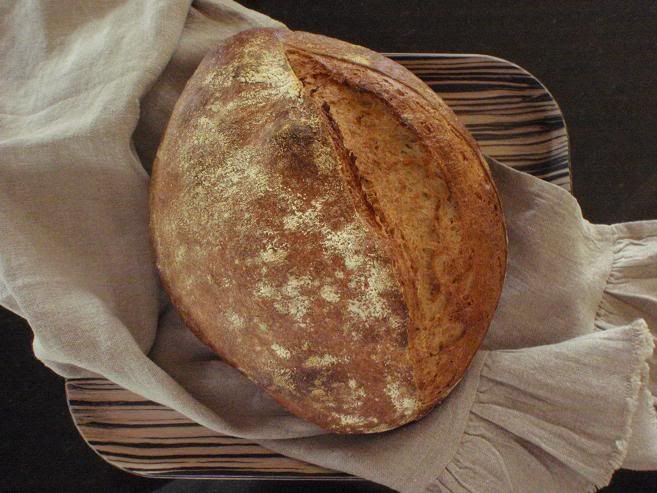
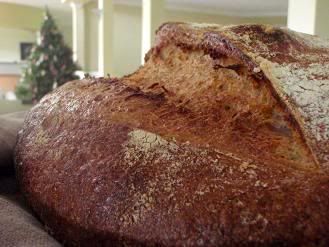
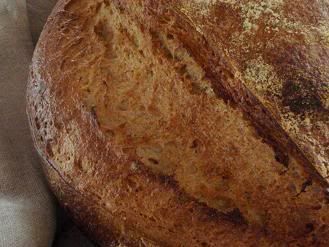
The bread looked gorgeous from the outside. That was only half of the story. The crumb revealed the other half of the story:
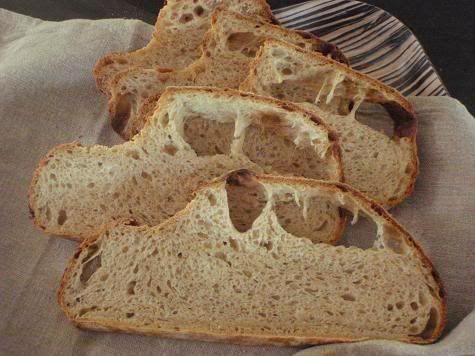
[color=blue][b]London cabs?[/b][/color]

[color=blue]THAT hole was where my thumb was (see point (2) below)[/color]
While the crumb was lovely to taste, springy to bite, and not altogether dense, I did not develop the [b]full potential[/b] of the crumb as would otherwise be manifested in the open cell structure. I knew this because of what I was able to achieve in my last Chad Robertson bread, using similar formula. I looked back at what I had done differently, and I think the following was what happened:
(1) That my starter was over-ripe [b]before[/b] I did the two-hour expansion and, [b]despite[/b] the two-hour expansion, my starter was still "[color=red][b]tired[/b][/color]." My starter was not at its most vigorous when I used it to mix the final dough. And,
(2) That my stretch and folds could have been better executed. (I used my left hand to hold and stabilize the dough while my right hand folded it. As the dough was folded onto itself, my left thumb was in the way because I did the S&F's in a very quick motion as if I was in a hurry or racing to get the job done. The big hole in the crumb shot above was the mark that my left thumb had left behind.) The point here, however, is not about the hole so big that a mouse could sneak through. The point here is that I was stretching and folding the dough [b]too fast[/b] that the dough was not allowed an optimal chance for [b]proper[/b] gluten development [b]while the fermentation was happening concurrently[/b].
I came across the following remark in LeadDog's comment in a post, entitled "Exploring Bread" in Sourdough Companion that best exemplifies what I meant. He said,
When I was reading "Local Bread" Leader attributed the following concept to Max Poilane:
"Max explained how [b]slow, steady[/b] kneading [b]gently conditions[/b] the gluten to create an extensible and elastic dough. The modern practice of high-speed mixing while [b]hurrying along the process[/b], oxygenates the dough too much and bleaches it out, causing the bread to lose flavor and character."
In my formula above, there are at least two more elements that are not consistent with a French-style Country Sourdough. And these are (a) that the levain is normally a stiff levain, and (b) that the levain normally falls within 25 to 35% of baker's percentage.
Based on the foregoing, I gave it one more try at reproducing Chad Robertson's Country Sourdough that I had when I visited his Tartine Bakery last August in San Francisco.
[b][u][color=red]My formula for Bread Inspired by Chad Robertson's Country Sourdough[/color][/u][/b]
- 150 g [b][color=red]just ripe[/color][/b] stiff levain @60% hydration (30% baker's percentage)
- 41 g organic stone-ground medium rye flour (7% of total flour)
- 82 g organic stone-ground whole wheat flour (14% of total flour)
- 377 g organic unbleached plain flour
- 384 g water
- 11 g salt
Total dough weight was 1040 grams and overall hydration was [b]74[/b]%.
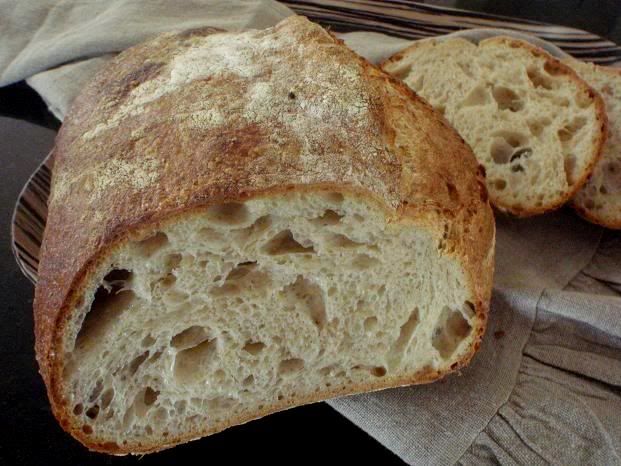
[b][u]Some main points of my procedure[/u][/b]
My room temperature was 28C. Over the three hours of bulk fermentation (from the time mixing was complete to the time I pre-shaped the dough), I did 4 sets of [b]slow and gentle S&F's[/b] of 25 strokes each, every 45 minutes or so apart.
At the end of each set of S&F's, instead of oiling a separate clean bowl to place the dough in, which I find really troublesome, I dab some oil at the edge of the dough where it meets the mixing bowl all round. This works really well - the oil protects the dough from tearing through the successive S&F's. I also oil my fingers so the dough doesn't stick to my fingers. I have a standing plastic container on the side, in which I have oil, ready to be used.
I proved my shaped dough for about an hour and then placed it in the refrigerator for a 12 hours retarding.

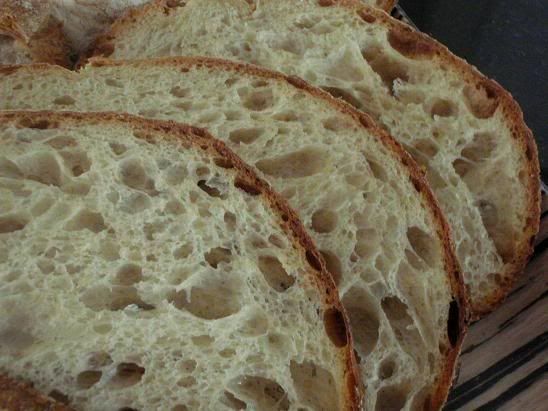
I am very happy with the result and will now close my book on Chad Robertson's country sourdough. If you are interested to try this recipe, the two-hour levain expansion is not necessary, but just make sure that your starter is very vigorous; under ripe, I think, is better than over-ripe; I would use it as soon as it domes.
The recipe looks simple. Its success, however, is all in the understanding of and management of the fermentation and gluten development processes simultaneously. They are independent of each other and yet co-dependent on each other.
This is the first time that I felt that our dough should be treated with love. "Slow and gentle S&F's" means love.
In closing, may I be presumptuous and say that I would like to bring your attention to a most beautifully written "Meet the baker" story by MC. So much love came out of her description of Gérard Rubaud, the man, the baker, and his way of making his Pain au Levain. If you can feel the love, your Pain au Levain will have come to a new level.
Shiao-Ping
- Shiao-Ping's Blog
- Log in or register to post comments
...of the first loaf. The picture of zen... The crumb of the second one is beautiful. Congratulations, Shiao-Ping! You can indeed close the book now.
Thank you, MC.
Shiao-Ping I did some slow and gentle technique this weekend and think I was too gentle. The gluten seemed developed but I don't think the sour dough starter got mixed into the bread as well as it could have been. The crumb isn't bad but here and there are these big holes that I think were maybe lumps of sourdough starter. Still fine tuning my method, maybe one of these times I'll figure it out.
Love (not always so tender!) is the X factor in all great home cooking, and bread baking is no exception. This belief informs my conviction that the greatest food is found in the domestic kitchens of the world - not Michelin Star restaurants (oh, the best street food is up there, too, such as that you can find all over SE-Asia, for example). Of course, I'm not referring to ALL domestic kitchens (or all street food)! There are important factors in great food other than this mysterious X!
Having several times baked your original 'Bread Inspired By Chad Robertson's Country Sourdough', Shiao-Ping, I am interested to try your new version. I rate the original pretty highly in terms of flavour, as I think I mentioned on that thread, so if this is better...my oh my! I can't wait.
PS: Thanks for the Meet The Baker link - great interview. You know, that interview reflects exactly the attitude I expressed in my comments on 'The Philosophy of Bread' in response to one of your recent posts on Sourdough Companion...but I'm sure you realised that.
Hi LeadDog,
(1) How do you normally mix your starter into the other ingredients of the dough? The easiest and safest way really is to add recipe water bit by bit to [b]dilute[/b] the starter [b]evenly[/b] before the flour is mixed in.
(2) How big are the holes? I may be wrong but I think, if the holes are bigger than one inch (or say 3 cm) wide, then, that normally is a sign of improper stretch and folds, not lumps of sourdough starter.
(3) With regards to stretch and folds, I think I should add a wording "[b][color=red]assertive[/color][/b]" after the wording "slow and gentle." I don't know if you have ever seen people playing Tai-Chi on an early Sunday morning in a park. The slow and gentle movement belies the strength underneath the movement. There is often a world of difference between how a student does a certain movement and how the master does it, even though they may appear to be doing exactly the same movement. The stretch-AND-fold movement is slow and gentle but it is also assertively performed in that the dough is getting a good exercise [b]from the bottom up[/b]. At each successive S&F, the dough should feel more and more [b]elastic[/b] - a sign of dough strength and proper gluten development. With this dough strength, you will then have volume and open cell structure [b]IF[/b] your starter is healthy and robust to properly ferment the flour.
(4) There are many factors at play in making a good end product. When we get one element right, there is no guarantee that all other factors are aligned. What is confusing for us is some factors can be variable (ie, not rigid). I am sure you will be able to recognize them the more you are familar with your dough.
Shiao-Ping
I normally mix the starter in with the water first. I was trying to see how little little kneading I could get away with and make a good dough. The dough felt really good, in fact I would describe it as beautiful. I did a coupe of stretches like I normally do. Really the only thing different is doing a lot less kneading/mixing so I'm thinking the starter didn't get mixed into the dough as well as it should have been. The holes are less than an inch but is just a little bit off from what I would expect.
Yes you are right about getting use to this dough. I don't normally make bread that is 67% hydration. I'm learning and making subtle changes. The end result will be worth it when I figure out what I did that one time a couple of weeks ago.
Hi Shiao-Ping. Serene, is a really apt description of the feeling I get from your first bread picture. My first impression, was that of a lunar orbit picture of the moon. I mean that in a nice way. Your second bread pictures were beautiful as well. I love the lacy effect of your slices' crumb. Ray
It's funny you should say that. Serenity is MC's comment too. I do not feel the serenity. I look at the picture and all that I could see was what went on to make that picture possible. There is a certain angle, a certain expression that I look for when I am choosing my photo. Certain shot is at a particular angle with a particular light in the background or around the object that makes it lifeless or full of life. And I guess that you are saying with the first bread photo serenity is what come through to you. Thank you.
Shiao-Ping
Hello, Siao-Ping,
Your post was very helpful. I recognized some of my own bread in your first example, and I had never realized what made it come out that way. I also have good bread days, but those London cabs breads were a mystery.
One comment I might add about Tartine bread: it is quite caramelized on the outside, so I would leave it in a turned off, slightly vented oven until it's very dark (to reproduce the Tartine effect).
I'm going to go revive my sourdough so I can bake this tomorrow!
Thanks!
Pat
You are right that the Tartine sourdough is quite dark on the outside (the WFO effect?).
wasting your time. Just point me toward the answer.
I am confused by your term Stretch and Fold (S&F) followed by 25 strokes. I know Stretch and Fold to be manipulating the dough by stretching into a rectangle or square, folding in thirds, rotating 90°, folding again in thirds and returning the dough to its proofing container.
I also use a manipulation I call a French Fold (learned from a video I watched) wherein the dough is turned out, picked up by an end, stretched by gravity or centrifigal force (swinging the dough) then spreading the portion in your fingertips and folding it over the stretched portion of the dough. Subsequently, one picks up an end of the dough in a manner that the dough is rotated 90° and repeating the swing and fold over operation. I think of each repeat as a stroke. This manipulation can be done very gently, or aggressively by varying the strengh of the swing motion. Is this what you call S&F?
If not, please guide me.
Thanks,
David G
Hi David G
Sorry I was not able to reply sooner.
The S & F that I used with my Chad sourdough bread is, firstly, stretching a corner of the dough [u][b]in the mixing bowl[/b][/u] (ie, lifting a corner up about 5 to 10 cm high) then folding it onto itself; then, giving [u][b]the mixing bowl[/b][/u] a quarter turn, and repeat same. What I call one stroke is one stretch [b]with[/b] one fold in the mixing bowl. I shall call this [u]S & F in the mixing bowl technique[/u]. This works for me because all my mixing is done in a mixing bowl by a big bread knife.
The letter folds are the original S & F technique that I learned. As you know, it is normally done in a big container or out on the kitchen bench then place back into the container (which is lightly oiled). Recently, I have also been doing my letter folds [b]in the air[/b] between hands and then place the dough back into the mixing bowl (then cover it in plastic wrap).
The French Fold is the slap and fold method as you described. But I don't do it.
Let me know if this is not clear.
Shiao-Ping
Thank you. I do something similar, using a bowl scraper, but didn't know it had a name.
David G
This is a gorgeous country sourdough. I have been looking to make some nice Country Sourdough bread. This is a keeper and I hope to make it soon. I especially love the look of the crumb. It has been mentioned before about looking between the larger holes in the crumb...lovely, Shiao-Ping!
Sylvia
Thank you, Sylvia.
Yes, "looking between the larger holes in the crumb." Sometimes the crumb may be open and the holes may be big, but the crumb may still be "dense." I have now learned that it is not the holes that are important. It is the part of crumb where there are NO holes, that is important to look at. That is the area that would give me indication as to whether or not I've got a properly fermented loaf. I would like to see, in the part of crumb where there are no visible big holes, that each and every ell is aerated (ie, that each and every cell has been properly fermented). That is a standard that my Chad country sourdough did not reached (but my recent T110 Miche has and that you have kindly commented on too).
Shiao-Ping
Hi,
How do you convert a liquid starter into a stiff starter? I normally fed my starter with the same weight flour and water. It is pretty runny and I make the Chad Robertson version of Country loaf. I tried the Gerard Rubaud bread but I used far too much dusting flour as he seems to do that in his video. I am not defeated though and will give it another try but I would like to stiffen my starter up in order to try this bread again.
Your liquid starter is 100% hydration. A stiff starter is 50-60% hydration. The easiest way to convert your liquid starter to a stiff one is to reserve 100 gm of your starter and add to it 100 gm of flour and 60 gm of water. You do this twice daily for at least three to four days or more until you observe that your starter is very active. If it gets too active, you can increase flour and water proportionally (say, 150 gm flour and 90 gm water), but if it looks sluggish, you can increase just the water, but eventually you must drop the water to only 50-60% of flour and stabilize at that percentage, or it’s not a stiff starter.